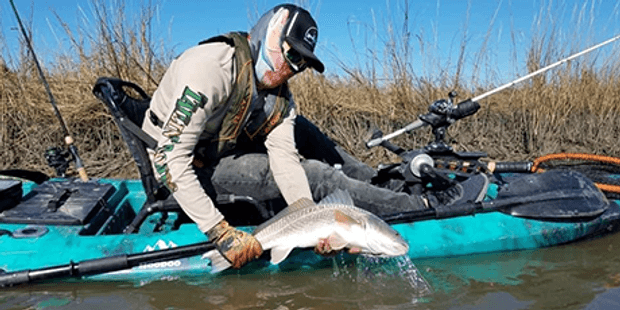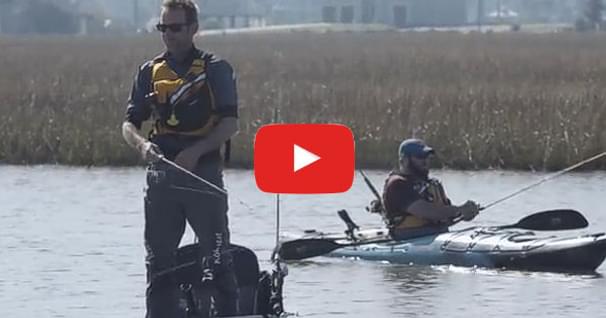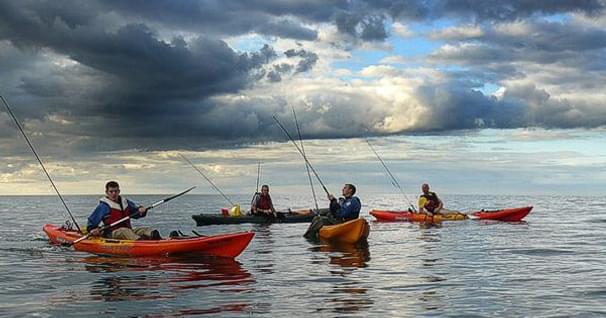Using and Installing Depth Finders on Fishing Kayaks
This alternate depth finder or other types of electronics is not a new
concept to Kayak Anglers, however, most Kayak Anglers out for the most
inexpensive unit that they can find because they think all I need to do
is find the bottom. That's not necessarily true - the more information you
have at your disposal the better.
I'm a big fan of having a combination unit GPS and sonar in one system so that it shows me where I'm at and what I'm fishing simultaneously. The cool thing about this setup and the slide track system installed on the Wilderness Systems kayaks is that I can use a Ram Mount. So when I'm sitting in the seat...have easy access to my depth finder. And if I want to move it out of the way, to paddle and cover a lot of water, I can simply rotate it back and lock it into position. It doesn't interfere with my paddle stroke. Additionally, when I want to hop up to the captain's seat, I can loosen this up..loosen the mount slide it further back rotate my depth founder back and I can reach it even when I'm in the upper seating position. Additionally, I like to stand and when I want to stand and fish, I don't want to have to give up using my depth finder.
A lot of bass boats are equipped with a big sonar unit by the cockpit and a smaller unit up in the front near the trolling motor. In a Kayak we don't have that luxury, so you need to find a unit that you can get a lot of bang for your buck. And with this little ranch unit, and a ram system and the wilderness systems slide tracks combination you can simply fold the unit over, rotate it flat, tighten it back up, and when you're standing you've got a perfect view of your depth finder, your GPS and you stay on top of your presentation.
~Fishing Kayaks from Hoodoo Sports~
Looking for a high quality fishing kayak at a reasonable price? Check out Hoodoo's lineup featuring the new dual-drive Impulse.
Okay. Obviously, to use a depth finder in your Kayak, you have to get power to it and Kayak can be a wet sport especially sit on tops. So what I've developed is a simple battery box, where your battery is connected, drill a hole in place at the grommet. Slide the battery inside, wedge a couple pieces of foam in there to keep it from rattling around, lock it down, and then tuck it underneath. And it's out of the way.
The next thing I want to talk about a setting up your transducer. For
years I went with the internal mount, either using some Goop, Flex Seal,
or other types of sealant to mount the transducer inside. More recently
water temperature is becoming an important part of the way I fish, and
the internal mounts are just not as accurate as they need to be. I'll be
honest, and tell you that when these external transducer mounts came
out I was a little bit skeptical. I fish in heavy cover, a lot of
thickets, and a lot of places where I thought this thing was going to
become a hindrance. I've been using it now for quite a while and it's
not as big of a problem as I thought. What I did though, is make a
couple of modifications that make this a lot cleaner for fishing in
those hard-to-reach places.
First I covered my transducer cable with some industrial sized heat shrink. The next thing I did is I cut the bar, to allow it to be rotated and used a simple throb screw, so that when I needed to get it all the way I can rotate it up and bring it around and store it so that's out of the way when I'm in shallow water or around thick cover.
Related Articles
In this video, Jeff Little shows you how to install a rod holder on a fishing kayak. Now, I already…
Fishing kayaks come in all different shapes and sizes and it's important that you choose the right one.…
Have you noticed that every time you go out to fish that you see more and more fellow paddlers ? I'm…



